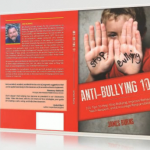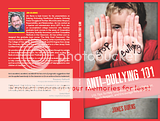by James Burns | Feb 8, 2018 | Conduct or Clinical, James Burns, Respect

Kids who have conduct problems should not be confused with kids who have Oppositional Defiant Disorder. Kids with this disorder are lacking an important piece of their personality: a conscience. These kids say and do things and can justify and defend their position to a point where it almost makes sense to others. Pretty disturbing. This kid can, at times, make you believe that when they bullied someone, the victim deserved the treatment. They lack empathy and have little or no remorse for their actions. They are truly anti-social and everyday are moving closer to becoming the adult sociopaths that makes the news for committing cruel and bizarre acts in society. He/she needs to be helped right now. His actions need to be watched and documented. He/she needs a combination of consequence and compassion, with the goal of helping him/her develop a greater regard for the rights and privileges of others (respect). Make no mistake about it; this kid has the potential to be dangerous. Accept no excuses, keep a balanced approach (consequence and compassion), don’t feel sorry for him, and help him/her change what may already be made up in his/her mind.
Visit My Store
by James Burns | Feb 7, 2018 | Conduct or Clinical, James Burns, The Bully Proof Classroom
Visit My Store
Bullies and victims suffer from clinical issues all the time. Depression, anxiety, and mood swings all are part of the bully/ victim dynamic. As these issues become more and more obvious, the natural tendency of parents and educators is to lower their expectations and modify the school environment to reduce academic and behavioral pressure. This may not be the best idea. Kids who already feel less-than-adequate and are suffering from a low sense of self-worth don’t need to feel any less capable then they already do. So let’s try something different: make any modifications you need to help kids who have been identified as “clinically involved.” But, slowly increase responsibility over time. Get him/her to a point that when he/ she has completed an assignment, arrived to school on time, or confronted a bully by being brave for two minutes, he/she feels like it was done on their own. Lowering expectations may appear to be the best thing to do at the time, but understand, we need to prepare kids to function in the real world where modifications may not exist. Kids will always provide you with the evidence to support your belief, so start believing that they are capable and they might surprise you.
Buy – Is The Behavior Conduct or Clinical
by James Burns | Nov 27, 2017 | Behavior Management, Conduct or Clinical, Educational Models
If you were to pick up a textbook on educational methodology and looked through it you would find models that educators have used for years. And I mean for years. A current textbook will have the same models in it that were considered current forty years ago. In the past these models were proven to help educators deal with student academic and behavioral performance and were part of the intervention process when students struggled with social, emotional, and conduct issues. Educators have used these models with some success but, as we have moved through the generations these models have suffered from what I call over use injury. The models haven’t changed but student behavior has, and the models have been used more now as a crutch than an intervention and do very little to help educators deal with the chronic behavioral issues in their schools. Behaviors such as disrespect, irresponsibility, bullying, violence, power struggles, lack of student motivation, clinical issues such as depression and ADHD and other issues were all problems that educators faced many years ago, but the intensity and frequency of these behaviors has become now the norm and not the exception. Let me make something very clear; an intervention is only an intervention if student behavior changes. Using an intervention that students are now immune to will only ceremoniously allow educators to say that something is being done; whether it works or not. So, what are these models? There are four of them, the biological/organic model, the behavioral model, the environmental model, and the psycho-educational model. All of them had their advantages many years ago, but now they suffer from as I said earlier over use injury and may only work in a very controlled environment such as prison, or an inpatient psychiatric unit. Let me spell out for you how these models were used and are used now and help you understand how intergenerationally students have adapted to these interventions and why they no longer net the same results that they did in the past.
The Organic/Biological Model
Our bodies can at times suffer from organic imperfections that can cause high blood pressure, cancer, stroke, or other diseases that can be treated with medications or other medical interventions that basically can keep a person alive. The wonders and the evolution of medicine have increased society’s life span by more than 15 years since the 1940’s, and is a necessary commodity if a person wants to maintain quality of life. Usually a blood or other test reveals the cause of certain symptoms that prompts the doctor to place his/her patient on medication to lower blood pressure or aid in the relief of those symptoms. Children who are behavioral problems have too often been treated with Ritalin or other psychotropic drugs as a means of controlling out of control behavior and all too often these drugs are used as the first resort and not the last. As an administrator I have called many parents about their child’s behavior only to be told that the child didn’t take his pill that morning or that the prescription has run out and they have to get to the doctor or the pharmacy for a refill. The debate is not whether or not to medicate a child, rather the debate is what the medication does to a child and is medication the only answer. Those in the mental health industry will tell you that therapy along with medication nets the best result when dealing with a client, it would seem rather apparent that medication along with fair, firm, and consistent discipline that is balanced with rules and compassion would net the best result in education as well. The truth is the so called quick fix may be what we are looking for. A person with high blood pressure has to take responsibility for his own health by walking, eating right, and watching his weight; this along with medication will help to lower his blood pressure. Students need to take responsibility for their behavior through the imposition of consequences, if not the only thing educators can expect is temporary relief, not permanent help.
Parents who discover that their son or daughter may have ADHD are at times relieved to find this out because they then can transfer the burden of responsibility to the school who they will claim doesn’t understand their child’s condition and can very easily convert the reasons for the child’s unruly behavior to an excuse. Once excuses are used behavioral problems escalate and by default we can unwittingly agree with the behavior as it hides behind the condition. In reality it may not be a condition at all rather, a learned behavior.
The organic/biological model can at times cause educators to lower their expectations for student behavior as well. As a teacher I would meet parents at conferences only to discover that the parent in their own way had the same personality characteristics as their child. This discovery would send me to the faculty room crying out “I know now why Joe is the way he is, I just met his father or mother and they’re as weird as he is.” I will admit that once this happened I saw no hope and began to lower my expectation for the student. Genetics only influence student behavior, they don’t determine it. A person can change their response to the influences of poor genetics and begin to unlearn some of the behaviors that are interfering with his/her learning. Students need to be taught how to rise above any genetic imperfection and this can only happen when we increase our expectations. Lowering expectations will only give the student the idea that they are incapable of not behaving in a manner that is acceptable to a family, a school, or society in general.
The Behavioral Model
When students or even adults contemplate certain actions they do so based upon two very important outcomes. What am I going to gain, and what am I going to lose. If the lose is great enough the risk might be too high. If the risk is at a minimum they may jump in feet first. If the consequence from the loss is too great they may evaluate taking that risk again. Students are in a constant state of evaluation and ask themselves these questions when they are thinking about doing something that could result in some uncomfortable consequences. For students who lack good judgment and are always involved in some type of misconduct educators use a behavioral approach and place the student on a behavior modification program. In other words they receive a reward for acting and behaving in appropriate ways as opposed to exhibiting poor judgment. If I understand this correctly students are rewarded when they change their behavior; which makes sense. But, what about the students who exhibit positive behaviors all the time, where is their reward? To the students who are always on the right track it would be to their advantage to act up and then change their behavior once they receive their reward. Behavior modification does work, but it is so extrinsic that students can’t maintain their positive behavior once the rewards stop coming. Many years ago students were rewarded for going above and beyond the behavioral expectations of the teacher, now students are rewarded for what they should be doing anyway, such as staying in their seat or being on time for school. Because of the over use injury that this model has sustained kids look to be rewarded for anything and everything. The students feel good about themselves for no apparent reason, it is a temporary fix, and once the novelty of the reward wears off the behavior continues. In addition the stakes have been raised with children in homes being given high end items for doing something that in years past would have been viewed as daily household chores. The same is true with the use of praise. A student could exhibit positive behavior for a day or two and the teacher falls all over this child with an avalanche of positive comments that do nothing more than put pressure on the student to continue to live up to expectations that he/she is incapable of. Praise if given too frequently can become like white noise in the mind of the student with him or her almost not believing the comments themselves. Praise needs to be given on a 1-9 ratio, for every one correction there needs to be nine statements of praise doled out. With ten months in the school year that should be one solid comment of praise once a month. In between educators need to strengthen their relationship with their students by practicing the 2X10. Two minutes a day for 10 days straight a conversation needs to take place with a student that is the most unlikeable and unruly. This conversation will strengthen the student/teacher bond and by the eighth day the student will be looking for the conversation. This breeds respect which if not present no amount of praise will change student behavior.
The Environmental Model
As a special educator I used the environmental model much of the time. My students needed to work at desks that had blinders on them, use head phones, and were given individual instruction. With behavior problems the students were spread out all over the room to avoid verbal confrontations. The environmental model worked. By today’s standard the environmental model has taken on a whole different meaning. Parents request that their child’s schedule be changed because they are not getting along with the teacher or other students in the class. Students are now given individual personal aids to monitor them because their behavior is so out of control. No Child Left Behind standards now have teachers preparing individual lessons for many students in their room with two or three teachers in the room to aid with instruction. The environment has been modified to a point where more emphasis is placed on the 20% of the students with difficulty rather than on the 80% who want and deserve a quality education. The environmental model suffers from severe over use injury and no longer is used in education for what it was intended for. In reality environments are not modified for adults in the work environment. Oh, if an individual has a disability and needs modifications to perform their job duties they are protected under law but no employer will modify an environment due to an individuals poor social skills or lack of motivation. A person with this type of profile will provide all the evidence that will support the employer’s belief and they most times will be terminated. The environmental model needs to be used as an intervention to improve student performance not offer a way out due to poor behavior or social inadequacies.
The Psycho-Educational Model
When a student’s behavior is out of control what factors in the student’s life do we have to consider? Some educators may consider the following: The parent’s are going through a messy divorce, alcoholism in the family, the student broke up with his/her boyfriend or girlfriend, low IQ, or they didn’t make a spots team. Which of these factors need to be considered? The truth is none of them. That is of course if you are a teacher. A social worker, behaviorist, or school psychologist would consider them all, and there in lies the problem. Teachers and support staff like the ones mentioned never have and never will get along in a school environment: why: because teachers seek consequences for inappropriate behavior and social workers et.al. seek reasons. This model has been over used and has suffered injury due to the fact that accountability for poor behavior has taken a back seat behind the guise of reasons which have become excuses. This model used to work well when teachers balanced their rules and regulations with compassion and understanding. That’s when the teacher did it all and offered an understanding ear after the student was disciplined. The minute that two people enter the discipline process a bad marriage begins to form with two very different philosophies being used. Students know this and just like parenting when mom says no ask dad, when the teacher is viewed as unfair enter the mental health professional to soothe the soul that feels maltreated. Some students need therapy and should receive it but it needs to be balanced with an environment that offers real world consequence.
The psycho-educational model has been misused and widely misunderstood by educators. The core psycho-educational principle is education has a role in emotional and behavioral change. . The rationale behind a psycho-educational approach is that, with a clear understanding of the mental condition, and self-knowledge of own strengths, community resources, and coping skills, the individual is better equipped to deal with the problem and to contribute to his or her own emotional well-being. Consequently, improved awareness of causes and effects leads to improved self-efficacy (the person believing that he is able to manage the situation), and improved self-efficacy leads to better self-control. In other words, the person feels less helpless about the situation and more in control of himself or herself. This model if used correctly can make a difference in the lives of students and parents as long as in the process of disciplining students educators and other mental health professionals work together in understanding a student’s diagnosis and use that diagnosis to educate and improve student accountability and not excuse unruly behavior behind a condition.






